<if>元素
动态 SQL 通常要做的事情是java培训有条件地包含 where 子句的一部分。所以在 MyBatis 中,<if>元素是最常用的元素。它类似于 Java 中的 if 语句。在 ch8 应用中,测试<if>元素,具体过程如下:
本小节继续使用上一章的实例,在 com.mybatis 包的 UserMapper.xml 文件中,添加如下 SQL 映射语句:
<!-- 使用if元素,根据条件动态查询用户信息 --> <select id="selectUserByIf" resultType="com.po.MyUser" parameterType="com.po.MyUser"> select * from user where 1=1 <if test="uname !=null and uname!=''"> and uname like concat('%',#{uname},'%') </if> <if test="usex !=null and usex!=''"> and usex = #{usex} </if> </select>
复制代码

点击并拖拽以移动
这个<select>元素中 parameterType 用的是 POJO 类 MyUser。所以 SQL 语句中的 #{uname}和 #{usex}的值都是 MyUser.uname。
当要构造动态 sql 语句时为了防止 sql 语句结构不当,所以加上 where 1=1 ,这样 SQL 语句不会报错,后面的逻辑也很简单,判断 #{usex}不为空且不为""的时候在后面添加 SQL。
对应的 Dao 接口:
public List<MyUser> selectUserByIf(MyUser user);
复制代码

点击并拖拽以移动
测试用的 Controller:
// 使用if元素查询用户信息 MyUser ifmu = new MyUser(); ifmu.setUname("张"); ifmu.setUsex("女"); List<MyUser> listByif = userDao.selectUserByIf(ifmu); System.out.println("if元素================"); for (MyUser myUser : listByif) { System.out.println(myUser); }
复制代码

点击并拖拽以移动
测试结果:

点击并拖拽以移动
我们试着不设置 #{uname}的值,看是否正确拼接了 SQL 语句:

点击并拖拽以移动
<choose>、<when>、<otherwise>元素
有些时候,不想用到所有的条件语句,而只想从中择其一二。针对这种情况,MyBatis 提供了 choose 选择元素,它有点像 Java 中的 switch 语句。
映射语句如下:
<!-- 使用choose、when、otherwise元素,根据条件动态查询用户信息 --> <!-- 类似于Java的switch,注意:当一个when执行后,其他就不再执行 --> <select id="selectUserByChoose" resultType="com.po.MyUser" parameterType="com.po.MyUser"> select * from user where 1=1 <choose> <when test="uname !=null and uname!=''"> and uname like concat('%',#{uname},'%') </when> <when test="usex !=null and usex!=''"> and usex = #{usex} </when> <otherwise> and uid > 10 </otherwise> </choose> </select>
复制代码

点击并拖拽以移动
<choose>元素就是 switch 语句,<when>就是 case 语句,<otherwise> 就是 default 语句。同样需要注意的是,当一个<when>元素条件满足时候就不在执行<when>其他元素和<otherwise>了,将会直接结束整个<choose>元素。
Dao 接口:
public List<MyUser> selectUserByChoose(MyUser user);
复制代码

点击并拖拽以移动
Controller 中测试:
// 使用choose元素查询用户信息 MyUser choosemu = new MyUser(); choosemu.setUname(""); choosemu.setUsex(""); List<MyUser> listByChoose = userDao.selectUserByChoose(choosemu); System.out.println("choose元素================"); for (MyUser myUser : listByChoose) { System.out.println(myUser); }
复制代码

点击并拖拽以移动
我们例子中传入 uname 和 usex 为空,所以执行了<otherwise>元素中的语句,如图:

点击并拖拽以移动
我们这次传一个 usex 试试,看看语句如何执行:
// 使用choose元素查询用户信息 MyUser choosemu = new MyUser(); choosemu.setUname(""); choosemu.setUsex("女"); List<MyUser> listByChoose = userDao.selectUserByChoose(choosemu); System.out.println("choose元素================"); for (MyUser myUser : listByChoose) { System.out.println(myUser); }
复制代码

点击并拖拽以移动
结果如下,当不为 usex 空时,仅执行了这个 <when test="usex !=null and usex!=''">元素。

点击并拖拽以移动
<trim>、<where>、<set>元素
1. <trim>元素
<trim>元素的主要功能是可以在自己包含的内容前加上某些前缀,也可以在其后加上某些后缀,与之对应的属性是 prefix 和 suffix;可以把包含内容的首部某些内容覆盖,即忽略,也可以把尾部的某些内容覆盖,对应的属性是 prefixOverrides 和 suffixOverrides;正因为<trim>元素有这样的功能,所以也可以非常简单地利用<trim>来代替<where>元素的功能。
映射语句如下:
<!-- 使用trim元素,根据条件动态查询用户信息 --> <select id="selectUserByTrim" resultType="com.po.MyUser" parameterType="com.po.MyUser"> select * from user <trim prefix="where" prefixOverrides="and |or"> <if test="uname !=null and uname!=''"> and uname like concat('%',#{uname},'%') </if> <if test="usex !=null and usex!=''"> and usex = #{usex} </if> </trim> </select>
复制代码

点击并拖拽以移动
<trim prefix="where" prefixOverrides="and |or">的意思是:在整个 <trim> 元素范围内,为 SQL 语句加上"where"前缀,同时去掉"and |or"后缀。和我们第一小节的 where 1=1 是一个意思,智能拼接 SQL 语句。
对应的 Dao 接口:
public List<MyUser> selectUserByTrim(MyUser user);
复制代码

点击并拖拽以移动
在 Controller 中测试:
//使用trim元素查询用户信息 MyUser trimmu = new MyUser(); trimmu.setUname("张"); trimmu.setUsex("男"); List<MyUser> listByTrim = userDao.selectUserByTrim(trimmu); System.out.println("trim元素================"); for (MyUser myUser : listByTrim) { System.out.println(myUser); }
复制代码

点击并拖拽以移动
从测试结果中我们可以看到 Mybatis 智能拼接了 SQL 语句,加上"where"前缀,同时去掉了"and"后缀。

点击并拖拽以移动
2. <where>元素
<where>元素的作用是会在写入<where>元素的地方输出一个 where 语句,另外一个好处是不需要考虑<where>元素里面的条件输出是什么样子的,MyBatis 将智能处理。如果所有的条件都不满足,那么 MyBatis 就会查出所有的记录,如果输出后是 and 开头的,MyBatis 会把第一个 and 忽略,当然如果是 or 开头的,MyBatis 也会把它忽略;此外,在<where>元素中不需要考虑空格的问题,MyBatis 将智能加上,都是能够实现智能拼接 SQL 语句功能。
映射语句如下:
<!-- 使用where元素,根据条件动态查询用户信息 --> <select id="selectUserByWhere" resultType="com.po.MyUser" parameterType="com.po.MyUser"> select * from user <where> <if test="uname !=null and uname!=''"> and uname like concat('%',#{uname},'%') </if> <if test="usex !=null and usex!=''"> and usex = #{usex} </if> </where> </select>
复制代码

点击并拖拽以移动
在这个<where> 元素中,自动加上了 where 前缀,并且去掉了 and 后缀。
Dao 接口:
public List<MyUser> selectUserByWhere(MyUser user);
复制代码

点击并拖拽以移动
Controller 的测试:
//使用where元素查询用户信息 MyUser wheremu = new MyUser(); wheremu.setUname("张"); wheremu.setUsex("男"); List<MyUser> listByWhere = userDao.selectUserByWhere(wheremu); System.out.println("where元素================"); for (MyUser myUser : listByWhere) { System.out.println(myUser); }
复制代码

点击并拖拽以移动
结果同上一小节一样:

点击并拖拽以移动
3. <set>元素
在动态 update 语句中,可以使用<set>元素动态更新列。
映射语句:
<!-- 使用set元素,动态修改一个用户 --> <update id="updateUserBySet" parameterType="com.po.MyUser"> update user <set> <if test="uname != null">uname=#{uname},</if> <if test="usex != null">usex=#{usex}</if> </set> where uid = #{uid} </update>
复制代码

点击并拖拽以移动
在 <set>元素中,当 uname 不为空时,SQL 语句自动加上 uname=#{uname},也就是哪个列传来的值不为空,就会更新此列。
Dao 接口:
public int updateUserBySet(MyUser user);
复制代码

点击并拖拽以移动
Controller 中测试:
//使用set元素修改一个用户 MyUser setmu = new MyUser(); setmu.setUid(1); setmu.setUname("张九"); int setup = userDao.updateUserBySet(setmu); System.out.println("set元素修改了" + setup + "条记录"); System.out.println( "================");
复制代码

点击并拖拽以移动
从运行截图可以看到,因为 uname 不为空,所有修改这一列:

点击并拖拽以移动
<foreach>元素
<foreach>元素主要用在构建 in 条件中,它可以在 SQL 语句中进行迭代一个集合。foreach 元素的属性主要有 item,index,collection,open,separator,close。
item 表示集合中每一个元素进行迭代时的别名,即变量名。
index 指定一个名字,用于表示在迭代过程中,每次迭代到的位置,就是循环索引。
open 表示该语句以什么开始,通常构建 in 时候,以"("作为拼接 SQL 的前缀。
close 表示以什么结束。以")"作为拼接 SQL 的后缀,
separator 表示在每次进行迭代之间以什么符号作为分隔符,视传入参数的类型而定。
在使用<foreach>时,最关键的也是最容易出错的是 collection 属性,该属性是必选的,但在不同情况下,该属性的值是不一样的,主要有以下 3 种情况:
如果传入的是单参数且参数类型是一个 List 的时候,collection 属性值为 list。
如果传入的是单参数且参数类型是一个 array 数组的时候,collection 的属性值为 array。
如果传入的参数是多个时,需要把它们封装成一个 Map,当然单参数也可以封装成 Map。Map 的 key 是参数名,collection 属性值是传入的 List 或 array 对象在自己封装的 Map 中的 key,就是实际需要<foreach>元素遍历的值名称。
看着定义很繁琐,其实一个例子就能弄清楚了,如下。
定义映射语句:
<!-- 使用foreach元素,查询用户信息 --> <select id="selectUserByForeach" resultType="com.po.MyUser" parameterType="List"> select * from user where uid in <foreach item="item" index="index" collection="list" open="(" separator="," close=")"> #{item} </foreach> </select>
复制代码

点击并拖拽以移动
parameterType="List"表示传入的参数是 List,故而 collection 的属性是"list"。这段代码用 Java 解释为:
for (int index = 0; index < list.length; index++) { item=list[index]; }
复制代码

点击并拖拽以移动
对应的 Dao 接口,注意传入和返回的参数类型哦:
public List<MyUser> selectUserByForeach(List<Integer> listId);
复制代码

点击并拖拽以移动
Controller 中测试:
// 使用foreach元素,查询用户信息 List<Integer> listId = new ArrayList<Integer>(); listId.add(1); listId.add(11); listId.add(31); System.out.println("传入的参数为:"+listId); List<MyUser> listByForeach = userDao.selectUserByForeach(listId); System.out.println("foreach元素================"); for (MyUser myUser : listByForeach) { System.out.println(myUser); }
复制代码

点击并拖拽以移动
拼接后的 SQL 语句为:select * from user where uid in ( ? , ? , ? ) 。结果如图:

点击并拖拽以移动
补充:当传入多个参数,即 foreach 的参数为 map 类型时候
我们有时候需要多个条件的查询语句时候,如:select * from user where usex = ? and uid in ( ? , ? , ? ) 这样的语句时候,就需要往<select>元素中传入多个值,这个时候<foreach>元素中 collection 属性的值就得为<foreach>遍历中实际传入 item 的值了。同样的,看例子就懂了,如下映射语句:
<select id="getWorkShopByMap" resultType="com.po.MyUser" parameterType="java.util.Map"> select * from user where usex = #{usex} and uid in <foreach item="item" index="index" collection="maps" open="(" separator="," close=")"> #{item} </foreach></select>
复制代码

点击并拖拽以移动
Dao 接口:
List<MyUser> selectUserByForeachMap(HashMap map);
复制代码

点击并拖拽以移动
Controller 中测试:
// 使用foreach元素,查询用户信息 List<Integer> listId = new ArrayList<Integer>(); listId.add(1); listId.add(11); listId.add(31); HashMap map = new HashMap(); //注意这个maps对应<foreach>元素中collection属性的值 //因为我们需要其中的id值 map.put("maps",listId); map.put("usex","女"); System.out.println("传入的参数为:"+map); List<MyUser> listByForeach = userDao.selectUserByForeachMap(map); System.out.println("foreach元素================"); for (MyUser myUser : listByForeach) { System.out.println(myUser); }
复制代码

点击并拖拽以移动
注意这个 map.put("maps",listId);中的 maps 对应<foreach>元素中 collection 属性的值,因为我们需要这个 id 值来传给<foreach>元素解析。map.put("usex","女");中的 usex 对应 SQL 语句的 usex = #{usex},结果图:

点击并拖拽以移动
<bind>元素
在模糊查询时,如果使用“${}”拼接字符串,则无法防止 SQL 注入问题。如果使用字符串拼接函数或连接符号,但不同数据库的拼接函数或连接符号不同,如 MySQL 的 concat 函数、Oracle 的连接符号“||”。这样,SQL 映射文件就需要根据不同的数据库提供不同的实现,显然是比较麻烦,且不利于代码的移植。幸运的是,MyBatis 提供了<bind>元素来解决这一问题。
映射语句:
<!-- 使用bind元素进行模糊查询 --> <select id="selectUserByBind" resultType="com.po.MyUser" parameterType="com.po.MyUser"> <!-- bind中uname是com.po.MyUser的属性名 --> <bind name="paran_uname" value="'%' + uname + '%'"/> select * from user where uname like #{paran_uname} </select>
复制代码

点击并拖拽以移动
Dao 接口:
public List<MyUser> selectUserByBind(MyUser user);
复制代码

点击并拖拽以移动
Controller 中测试:
//使用bind元素查询用户信息 MyUser bindmu = new MyUser(); bindmu.setUname("张"); List<MyUser> listByBind = userDao.selectUserByBind(bindmu); System.out.println("bind元素================"); for (MyUser myUser : listByBind) { System.out.println(myUser); }
复制代码

点击并拖拽以移动
看看我们最后正确的字符串拼接结果:%张 %
运行截图:

点击并拖拽以移动
原创作者:浩





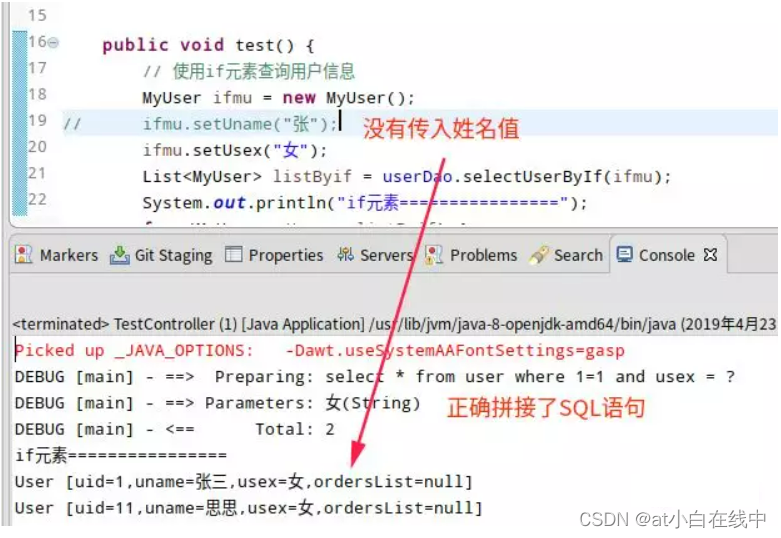




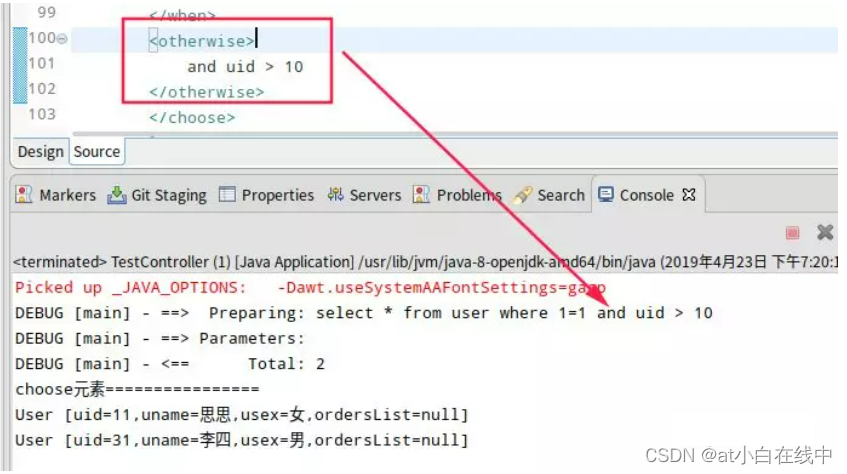


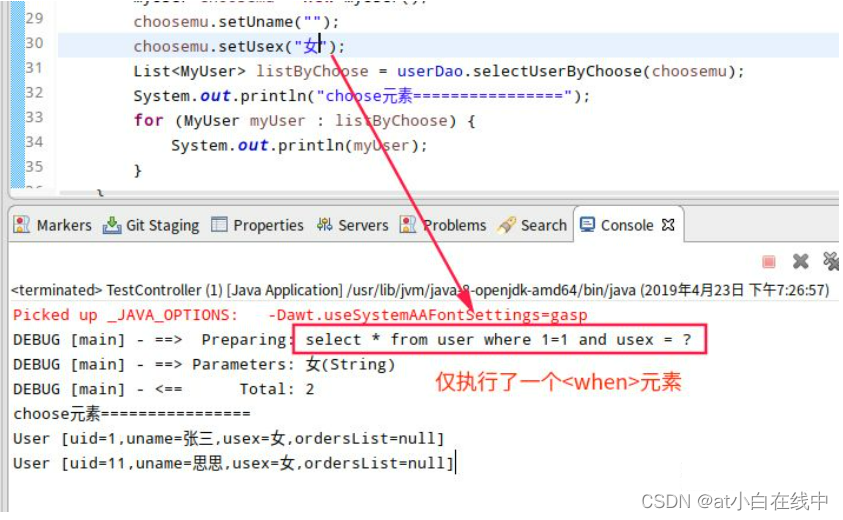









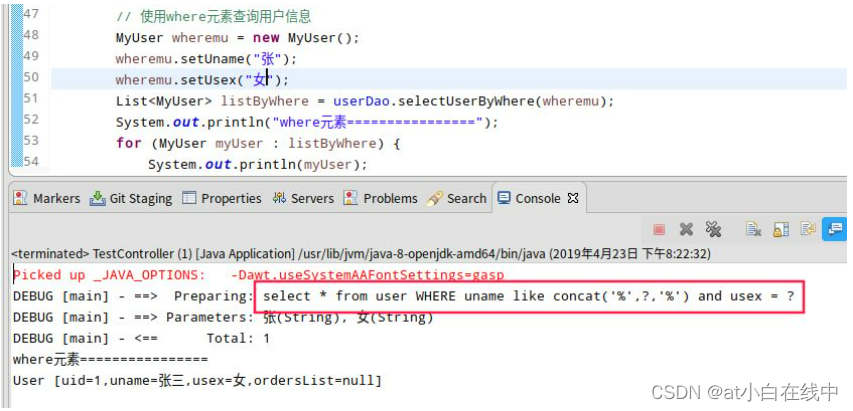




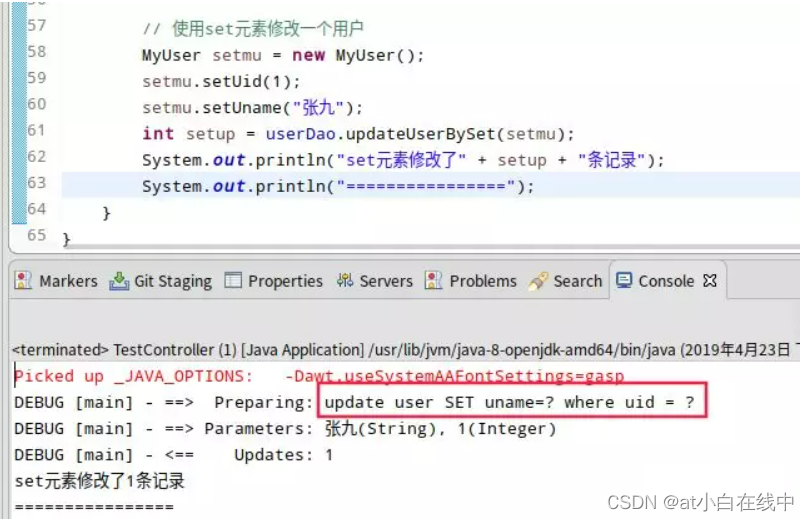










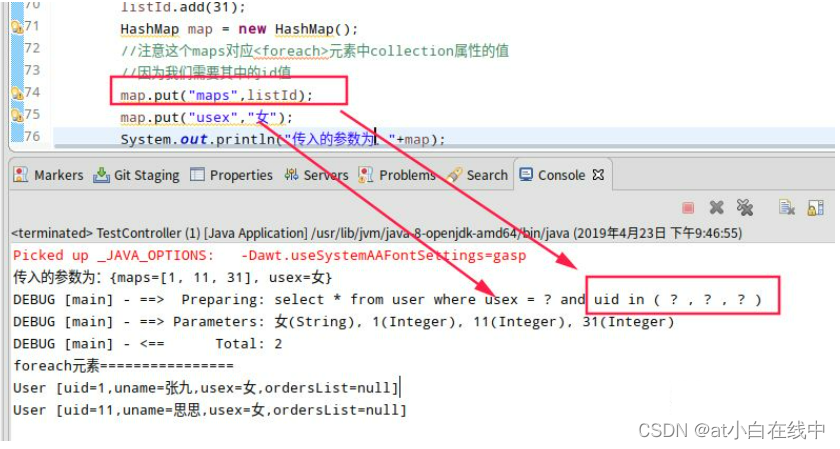




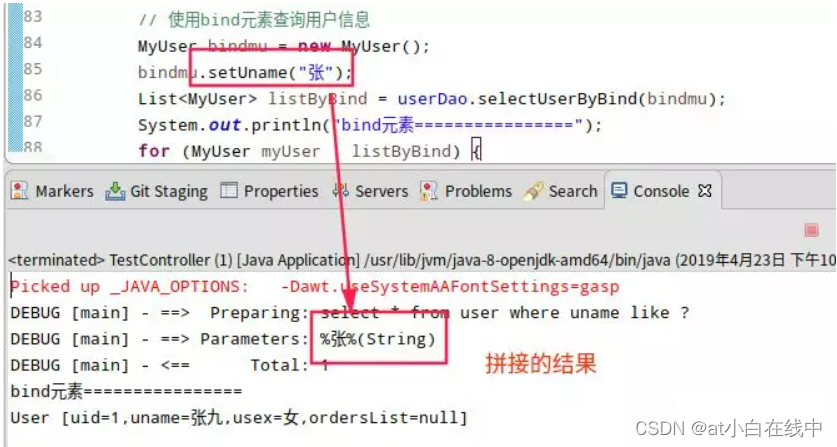













评论